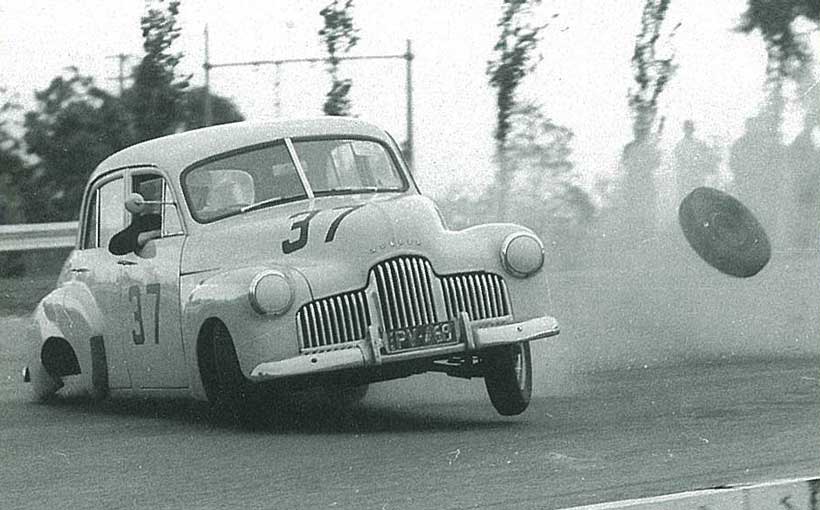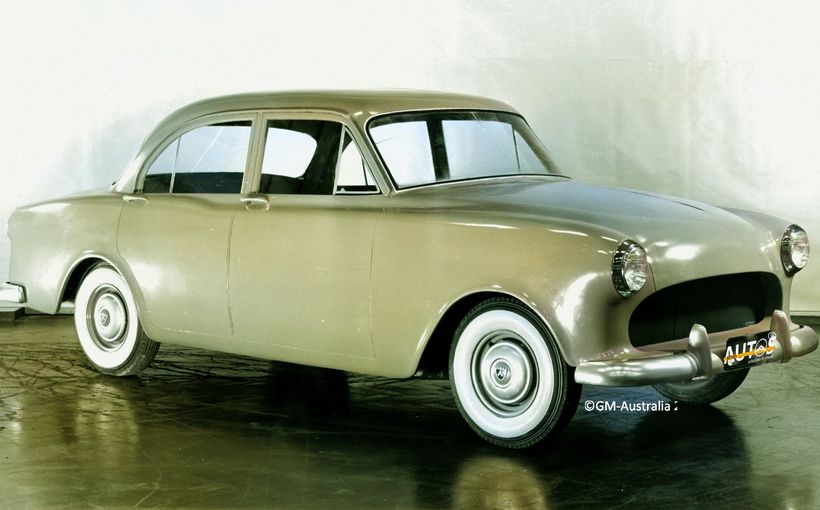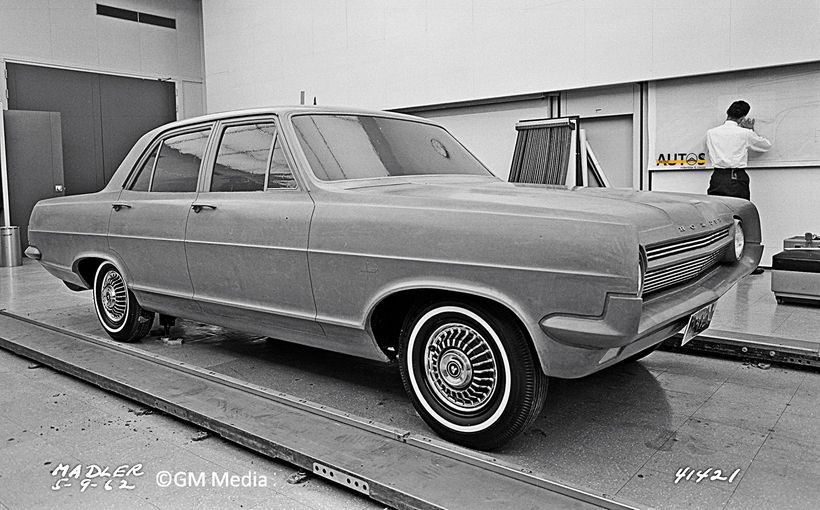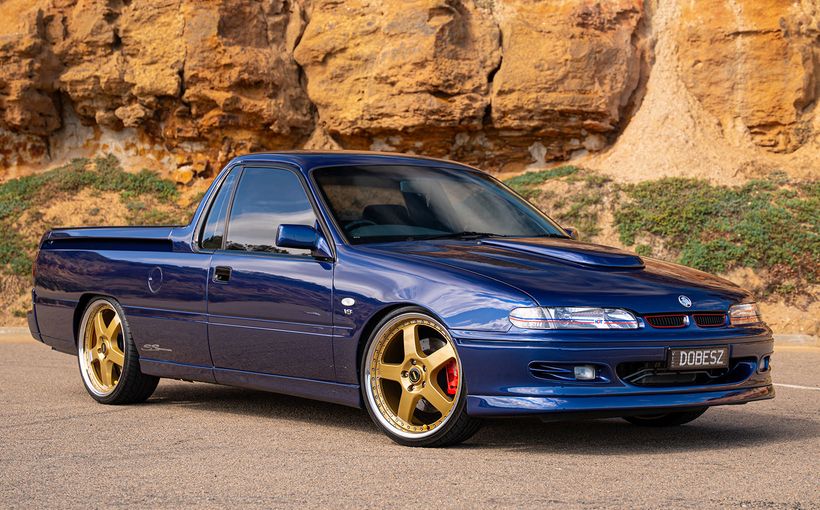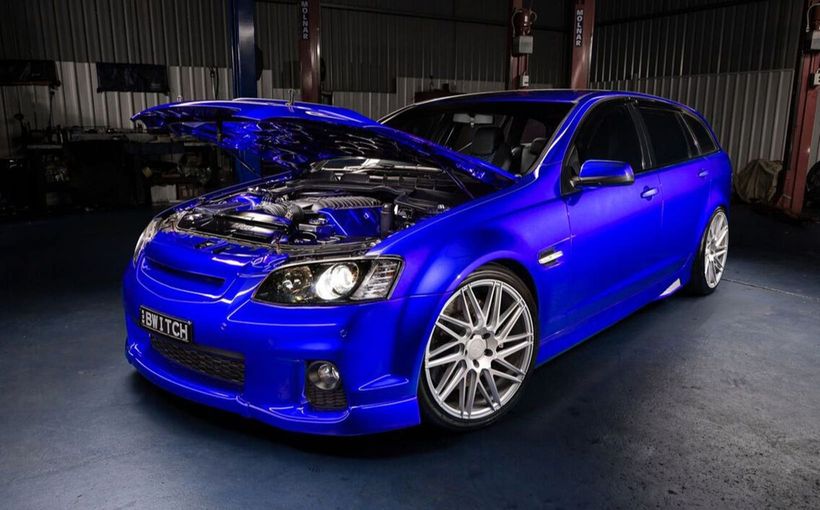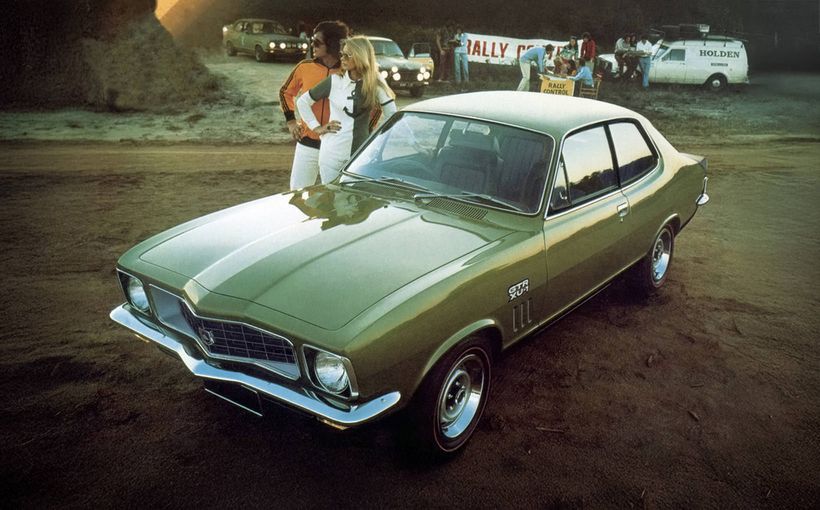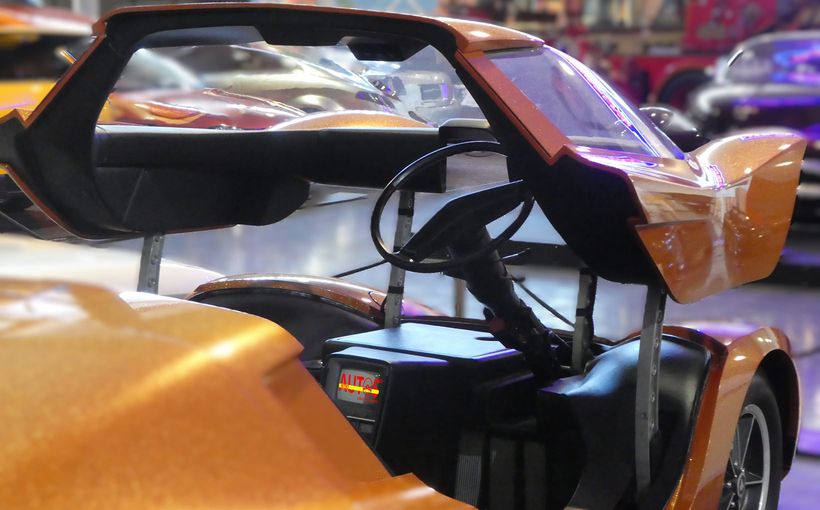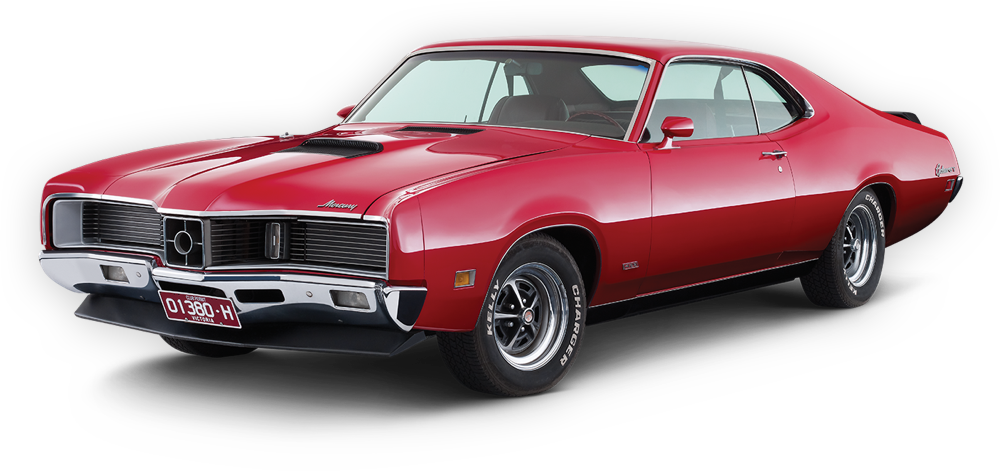48-215 & FJ Holdens: Rockin’, Rollin’, Tweakin’ and Cheatin’ in the ‘50s and ‘60s

The birth of ‘Australia’s Own Car’ in 1948 – the legendary Holden 48-215 – also played a pivotal role in the rapid growth and popularity of touring car racing to become the nation’s number one motor sport attraction.
There were two distinct periods of 48-Series Holdens as outright contenders in touring car racing. The first was the ‘outlaw’ years of the 1950s when rules were scarce and modifications ran way out of control. The top guns of that time included Jack Myers, Leo Geoghegan and John French.
The second period was 1960 to 1964, when they raced under a much stricter set of national touring car rules called Appendix J. The top guns of this era included now famous names like Norm Beechey, Ian Geoghegan, Des West, Barry ‘Bo’ Seton, Spencer Martin, Brian Muir, Midge Bosworth, Warren Weldon and Max Stahl. Although rule-bending was rife, this era produced some of the closest and fiercest touring car racing ever seen.

The 1950s
Although it’s hard to imagine today, back in the 1950s touring car racing was clearly the second tier of Australian motor sport. It was regarded as a poor cousin to the purist open-wheeler and sports car set that headlined major race meetings, driven by those that couldn’t afford ‘real’ racing cars.
Perhaps because of that, touring car racing’s popularity enjoyed healthy growth in the 1950s because it wasn’t too difficult or costly to squeeze some decent speed out of Holden’s readily available ‘Humpies’ along with the FE model released in 1956.
The 48-215 and its FJ successor, which together spanned the first eight years of Holden production, were excellent starting points for the budding touring car racer. Weighing just over a tonne and built on a 103-inch (2616mm) wheelbase using light but strong unitary construction, they were powered by Holden’s 132 cid (2.2 litre) inline six cylinder ‘grey’ motor which in stock form was rated at 60 bhp (45kW). This chassis-engine combination resulted in an excellent power-to-weight ratio for a family sedan of the time, capable of top speeds of around 80 mph (130 km/h).
Combined with a three-speed column shift manual gearbox, leaf-sprung live rear axle, coil-sprung upper and lower control arm front suspension and four-wheel drum brakes, these cars and their spare parts were in plentiful supply, cheap to buy and maintain and responded well to modifications.

In fact, it wasn’t long before a thriving aftermarket industry was established, supplying a myriad of locally-developed performance parts and tuning tips to get the best out of them.
This included Repco’s popular ‘High Power’ cylinder head designed by the company’s brilliant research engineer Phil Irving. He had identified the standard grey cylinder head’s poor gas flow, so in 1956 he designed another cast-iron head that would bolt directly to the standard cylinder block without modification. It was supplied as a complete across-the-counter kit for £167.00, which proved very popular with Holden racers crying out for an economical race engine.

Specially designed lightweight pushrods were matched with cast iron rockers mounted on individual shafts. The High Power kit included inlet manifolds, exhaust manifold plates drilled to accept 1 5/8-inch diameter pipes, a trick cast-aluminium rocker cover and engine side plate set plus all screws and gaskets needed for assembly.
The High Power’s free-flowing design really opened the lungs of the humble 2.2 litre inline six and spurred some rapid development amongst Holden racers.
At a time when the annual Redex (and later Ampol and Mobilgas) Round Australia Trials were still commanding most of the headlines for sedan car competition, the rivalry amongst the 1950s' circuit-racing crowd was becoming very serious indeed. Increasingly wild modifications were a growing problem for the sport’s administrators, not only in Holdens but UK and European marques too.

How quickly things had changed since Jack Myers, widely regarded as the pioneer of racing Holdens, had fronted with an iron-headed 48-215 in the early 1950s. He had described that car as being ‘fairly stock’ yet it could reach an astonishing 110 mph (177 km/h) and for three years he won just about everything there was to win.
Towards the end of the 1950s, though, the top guns in 48-Series Holdens were John French and Leo Geoghegan, driving cars so heavily modified that their links to the showroom products they outwardly represented were tenuous at best.
French’s fearsome two-tone green FJ featured a big breathing Repco head with triple Weber carbs (rumoured to be running on high octane methanol-based fuel), a Jaguar four-speed gearbox with floor shift and countless other outrageous tweaks. At one stage French even took a large slice out of the FJ’s bonnet from the top of the grille back to the base of the windscreen and welded in a section of flat steel sheet. This created a large sloping ‘wedge’ shape to improve its high speed air penetration.

And Geoghegan’s legendary black 48-215 also featured a slick-shifting four-speed gearbox (from an MG) and unique Repco head that was cast from lightweight aluminium, on a ferociously hot grey motor claimed to be producing around 167bhp (125kW) - nearly three times that of the standard engine!
This car also featured cutting-edge aerodynamic improvements, including smooth wind deflectors mounted either side of the grille and dome-shaped headlight covers to improve air penetration. It was even equipped with special underbody fairings designed to smooth airflow beneath the car. Considering that F1 didn’t start playing around with the science of underbody air flow until the mid-1970s, these guys were way ahead of their time.
By the end of the 1950s things were clearly spinning out of control. If touring car racing was to build on its growing popularity with both competitors and spectators, the sport’s governing body CAMS acknowledged that a major shake-up was needed. The arrival of David McKay’s Jaguar Mk I 3.4 in 1958, which in near stock form hosed these hot Holdens at Bathurst, showed the way forward.

The 1960s
From the start of the 1960 season, CAMS announced a new set of National Competition Rules for Touring Cars. And, in acknowledging that tin-top racing was becoming a major attraction, 1960 would also host the first Australian Touring Car Championship (ATCC) which would be held annually and contested over a single race of at least 50 miles (80 kms).
The highly-modified sedans of the 1950s, with their non-standard cylinder heads and gearboxes, huge brakes, stripped-out interiors, lightweight panels etc would compete in a new hybrid GT class called ‘Appendix K’ in which they would share the track with closed sports cars.
And a new class called ‘Appendix J’ would cater for a new breed of touring cars, which were permitted limited modifications so as not to stray too far from their showroom origins. Importantly, only Appendix J cars could compete for the newly announced ATCC title, so there was plenty of incentive for drivers to have a crack at this new more regulated form of touring car racing.
For its time, Appendix J was a simple, sensible and cost-effective set of rules - standard road cars with limited modifications allowed in specific areas to improve performance. It was designed to encourage more drivers to compete and also appeal more to spectators, by showcasing the same cars they could go out and buy from their local dealer.

Even so, these new Appendix J cars were seriously fast machines for their time. A detailed description of one of the top 48-215 Holdens of this new era, in Chevron’s Holden: The Official Race History by Stewart Wilson, provides some valuable insights:
“The 48-215 Max Stahl campaigned in 1962 and 1963 was a good example of one of the better Humpys. His car had originally been built in 1959 for Ian Geoghegan, went to Brian Muir in 1960 and then to Stahl. At the Easter Bathurst meeting in 1963, Stahl was clocked at 122.45mph (197 km/h) on Conrod Straight in this car – the fastest recorded by a Holden up until that point.
“It featured a (standard) iron cylinder head modified by Jim Wilkinson to produce a compression ratio of 12:1, 1.5-inch SU carbies, the mandatory three-speed column change, an increase in the cylinder bore from 75mm to 82mm (increasing the engine capacity to 2597cc), bigger valves, lightened flywheel, polished exhaust ports and extractors. The motor was balanced and produced 135 bhp at a redline of 6200 rpm running on 115/145 octane Avgas. Speeds in gears were 48, 80 and roughly 120 mph (77, 129 and 193 km/h).
“The car was lowered and fitted with a front (sway) bar and finned brake drums. It lapped Mount Panorama at 3 min 9.5 secs at that 1963 Easter meeting, some three seconds faster than Geoghegan’s best up to that time.”

As Wilson pointed out, other 48-215s later were credited with even more power and performance, Norm Beechey claiming a staggering 167 bhp (125 kW), 127 mph (204 km/h) top speed and a muscle car standing quarter-mile figure of 15.1 seconds by 1964.
Compare this to the 60 bhp and 80 mph top speed of the showroom version and you can appreciate the enormous performance gains achieved with these cars. Amazingly, this matched the figures of Leo Geoghegan’s much wilder pre-1960 era car with its trick aluminium head, stripped-out body, aero devices and all.
Not surprisingly, the aftermarket industry for Holden ‘go-faster’ bits that had sprung up in the 1950s continued to flourish into the ‘60s, with legendary names like Ken Waggott (Waggott Engineering) and Dave Bennett (Perfectune) synonymous with many of the leading cars.

It’s only cheating if you get caught
The bending of rules (cheating is such an ugly word) in Appendix J during the early 1960s was so rife amongst highly competitive 48-Series Holden racers that it developed into something of an art form.
Legend has it that scrutineers at Sydney and Melbourne tracks were generally regarded as the toughest to fool, so nobody got away with too much. In Tasmania, though, the car checking process was a far more relaxed affair, resulting in some of the most blatant rule-bending imaginable.
The lengths that some of the Apple Isle’s fastest Humpy Holden racers were prepared to go to in search of an unfair advantage was exposed in an insightful story by renowned motoring journalist Bill Tuckey published in Sports Car World in the mid-1970s.
Appendix J was by then a distant memory, but Tuckey’s vivid recall of an old mate’s 48-Series Holden that raced in Tassie during the early 1960s made compelling reading. It was no surprise that his mate remained anonymous after admitting: “I’m not all that proud of all the bloody skulduggery we got up to, but every driver was at it and you had to join them if you couldn’t beat them.”

Tuckey revealed that at a time when the mainland guys were boasting about their early Holdens doing 127 mph (204 km/h) down Conrod at Bathurst, the Tassie Devils were cranking 132 mph (211 km/h) on the nearly flat Mountford Straight at Longford, getting away from hot new 179 EHs in the process.
“The thing my mate drove started its trickery with a 12-volt battery poked into a six-volt casing – illegally of course,” Tuckey wrote. “He cut the tops of the front suspension towers to get the angles right and heated the banjo (diff) centre in a big press and bent the axle (housing) to get two degrees of neg. The tailshaft was ex-Customline, with the heavy-duty yokes machined to fit the Holden. He had an alloy flywheel and a big Dodge Six harmonic balancer to stop the habit of breaking cranks at $150 each. Some of this, of course, was legal and even the mainland guys bent the axles.
“But I don’t think they had spare wheels made out of fiberglass…he used plastic putty to make a mould, cast the wheel and painted it black. It would hold about 5 lb of air to give the tyre substance.The boot, when they inspected the tyre, looked beaut. It was all upholstered in hand-stitched leather. The scrutes would say ‘lovely’ and shut the lid. What they didn’t see under the leather was the whole rear bulkhead cut out and replaced by one diagonal brace and the floor pan replaced with fiberglass. Only that brace held the two sides of the car apart.
“The back seat was just a spring steel frame with the trim stretched over it and would collapse if anyone ever sat in it. But nobody ever did because three of the doors had their handles welded shut, mainly because all the door and window mechanisms had been taken out and steel rod welded in to keep the glass up. There were even little fiberglass lock buttons (glued) in the holes – in the locked position. Only the driver’s door would open and had everything working. The floors had their centres replaced with fiberglass and painted silver underneath (to look like steel).

“My mate started with Amal carburettors and then changed to Dell’Ortos which were also gravity fed. And here was the trickiest bit of all. On the firewall was a fuel box for the feed and behind that hidden under the dash was a little can full of (high octane) methanol. Under the left foot brace welded to the floor was a washer push-button and when the EHs were giving him trouble he’d pump it hard four or five times –and shazam, instant horsepower! The only trick was not to use it in the last three laps so it wouldn’t show up in the fuel check. ‘It gave you another 800 rpm and a real boot in the back’ he said.”
Tuckey’s mate also worked out how to disguise his car’s illegal locked diff at scrutineering time by ingeniously disengaging the axle shafts so that the car could be easily rolled into the scrutineering bay without the chattering rear wheels which are always a dead giveaway. When asked why his crew was pushing the car, he insisted it was purely to save wear and tear on the clutch. Simple.
Tuckey reckoned the whole car must have weighed only about 14 cwt (700 kgs) and it was one hell of a lot faster than anything the mainlanders ever took down there, as a few of the aces found out!

End of an era
The glory days of the grey-engined Holdens as front line touring car contenders were numbered as soon as the mercurial Jaguar Mk I 3.4s ran away with the first ATCC, which was held at Orange’s Gnoo Blas circuit in 1960.
The arrival of Bob Jane’s even faster Jaguar Mk 2 the following year further hastened the 48-series Holden’s demise, followed by the release of Holden’s new EH model in 1963 with the first of larger and tougher ‘red’ engines (179 cid) and a hot ‘S4’ competition option.
By 1965, with ‘Improved Production’ rules replacing Appendix J and the new Ford Mustang V8 setting a new touring car performance benchmark, the days of the 48-Series Holdens as outright contenders were well and truly over. It was the end of an important and unforgettable era in Australian motor sport.

